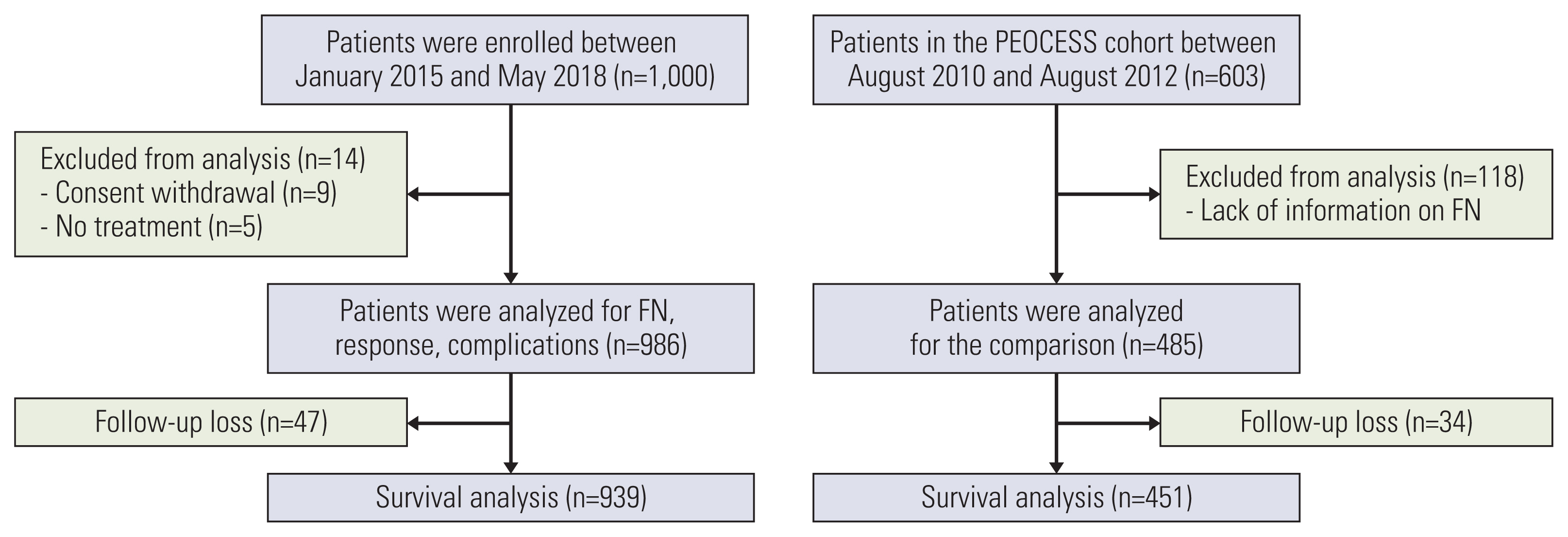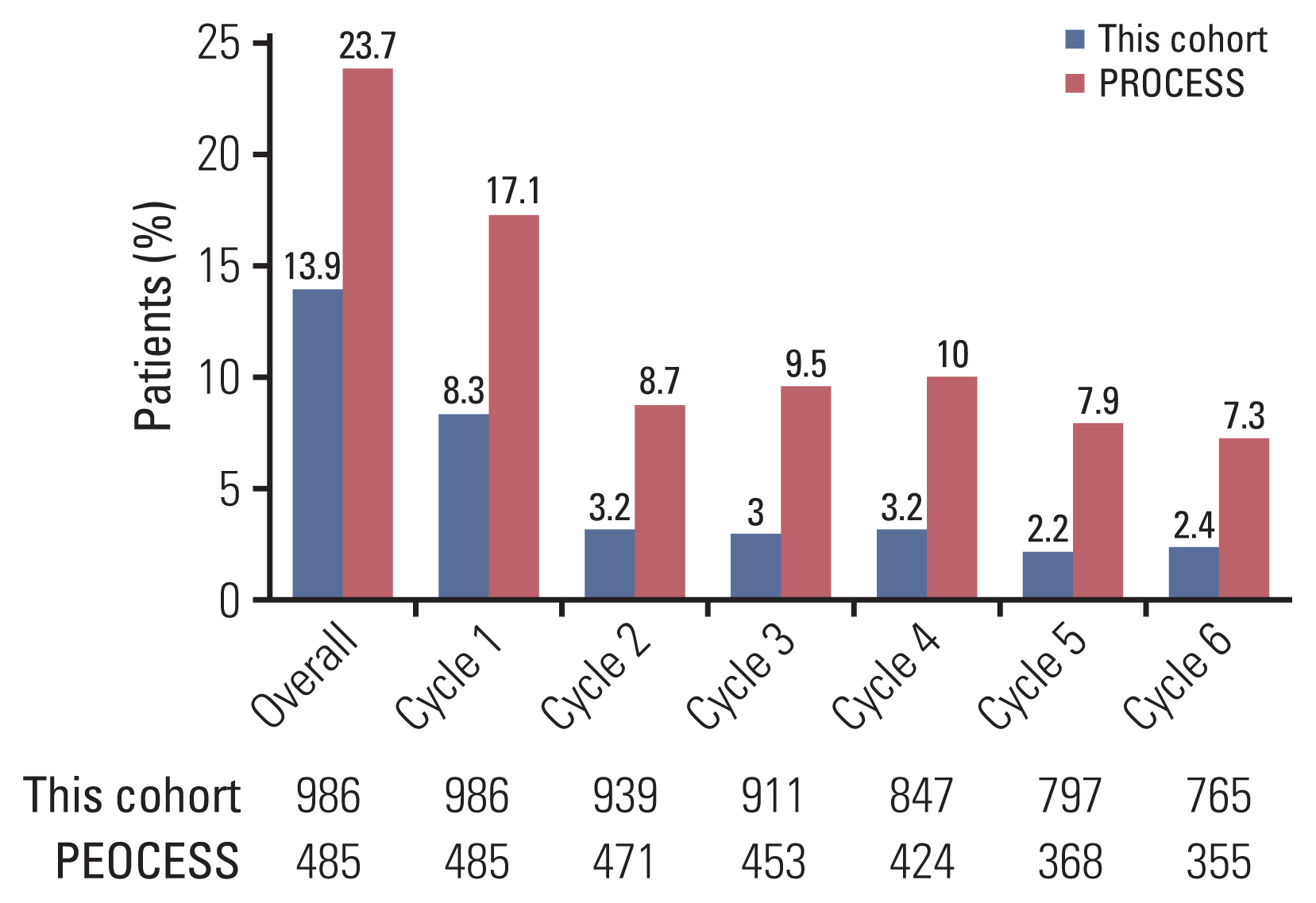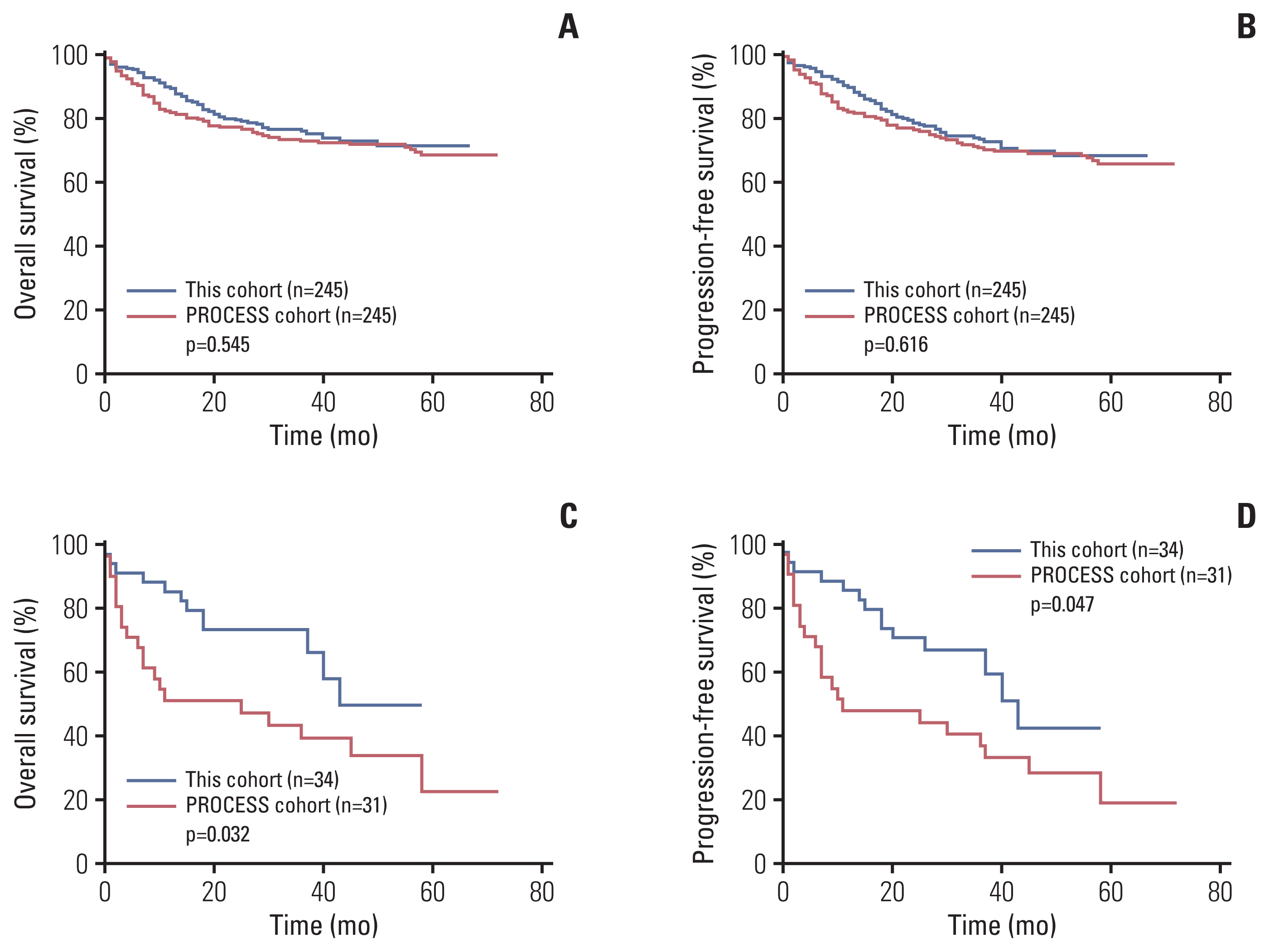Cancer Res Treat.
2022 Oct;54(4):1268-1277. 10.4143/crt.2021.1168.
Pegfilgrastim Prophylaxis Is Effective in the Prevention of Febrile Neutropenia and Reduces Mortality in Patients Aged ≥ 75 Years with Diffuse Large B-Cell Lymphoma Treated with R-CHOP: A Prospective Cohort Study
- Affiliations
-
- 1Department of Hematology-Oncology, Ajou University Hospital, Suwon, Korea
- 2Department of Medicine, Samsung Medical Center, Sungkyunkwan University School of Medicine, Seoul, Korea
- 3Department of Oncology, Asan Medical Center, University of Ulsan College of Medicine, Seoul, Korea
- 4Department of Internal Medicine, Korea University Anam Hospital, Seoul, Korea
- 5Department of Internal Medicine, Korea Cancer Center Hospital, Korea Institute of Radiological and Medical Sciences, Seoul, Korea
- 6Department of Internal Medicine, Seoul National University Hospital, Seoul, Korea
- 7Divison of Hematology-Oncology, Department of Internal Medicine, Gyeongsang National University Hospital, Gyeongsang National University College of Medicine, Jinju, Korea
- 8Department of Internal Medicine, Inje University Busan Paik Hospital, Busan, Korea
- 9Department of Internal Medicine, Chonnam National University Hwasun Hospital, Hwasun, Korea
- 10Department of Medicine, Dongsan Medical Center, Daegu, Korea
- 11Department of Medicine, Yeungnam University College of Medicine, Daegu, Korea
- 12Department of Internal Medicine, Gachon University Gil Medical Center, Gachon University College of Medicine, Incheon, Korea
- 13Department of Internal Medicine, Chungnam National University Hospital, Daejeon, Korea
- 14Department of Internal Medicine, Chung-Ang University Hospital, Seoul, Korea
- 15Department of Hematology and Oncology, Ulsan University Hospital, University of Ulsan College of Medicine, Ulsan, Korea
- 16Hematology-Oncology Clinic, National Cancer Center, Goyang, Korea
- 17Department of Internal Medicine, Chonbuk National University Medical School, Jeonju, Korea
- 18Department of Internal Medicine, Pusan National University Hospital, Busan, Korea
- 19Department of Internal Medicine, Hanyang University College of Medicine, Seoul, Korea
- 20Department of Internal medicine, Yonsei University Wonju College of medicine, Wonju, Korea
- 21Department of Internal Medicine, Inje University Ilsan Paik Hospital, Goyang, Korea
- 22Department of Internal Medicine, Chungbuk National University Hospital, Chungju, Korea
- 23Department of Internal Medicine, Dong-A University Medical Center, Busan, Korea
- 24Department of Internal Medicine, Hallym University Sacred Heart Hospital, Anyang, Korea
- 25Department of Internal Medicine, Inje University Sanggye Paik Hospital, Seoul, Korea
- 26Department of Hematology-Oncology, Soonchunhyang University Hospital, Soonchunhyang University College of Medicine, Seoul, Korea
- 27Department of Internal Medicine, Soonchunhyang University Bucheon Hospital, Bucheon, Korea
- 28Department of Internal Medicine, Kosin University Gospel Hospital, Busan, Korea
- KMID: 2534205
- DOI: http://doi.org/10.4143/crt.2021.1168
Abstract
- Purpose
Febrile neutropenia (FN) can cause suboptimal treatment and treatment-related mortality (TRM) in diffuse large B-cell lymphoma (DLBCL) patients treated with rituximab, cyclophosphamide, doxorubicin, vincristine, and prednisolone (R-CHOP).
Materials and methods
We conducted a prospective cohort study to evaluate the effectiveness of pegfilgrastim prophylaxis in DLBCL patients receiving R-CHOP, and we compared them with the PROCESS cohort (n=485).
Results
Since January 2015, 986 patients with DLBCL were enrolled. Pegfilgrastim was administered at least once in 930 patients (94.3%), covering 90.3% of all cycles. FN developed in 137 patients (13.9%) in this cohort (23.7% in the PROCESS cohort, p<0.001), and 4.2% of all cycles (10.2% in the PROCESS cohort, p<0.001). Dose delay was less common (≥3 days: 18.1% vs. 23.7%, p=0.015; ≥5 days: 12.0% vs. 18.3%, p=0.023) in this cohort than in the PROCESS cohort. The incidence of TRM (3.2% vs. 5.6%, p=0.047) and infection-related death (1.8% vs. 4.5%, p=0.004) was lower in this cohort than in the PROCESS cohort. The 4-year overall survival (OS) and progression-free survival (PFS) rates of the two cohorts were not different (OS: 73.0% vs. 71.9%, p=0.545; PFS: 69.5% vs. 68.8%, p=0.616). However, in patients aged ≥75 years, the 4-year OS and PFS rates were higher in this cohort than in the PROCESS cohort (OS: 49.6% vs. 33.7%, p=0.032; PFS: 44.2% vs. 30.3% p=0.047).
Conclusion
Pegfilgrastim prophylaxis is effective in the prevention of FN and infection-related death in DLBCL patients receiving R-CHOP, and it also improves OS in patients aged ≥75 years.
Figure
Reference
-
References
1. Coiffier B, Lepage E, Briere J, Herbrecht R, Tilly H, Bouabdallah R, et al. CHOP chemotherapy plus rituximab compared with CHOP alone in elderly patients with diffuse large-B-cell lymphoma. N Engl J Med. 2002; 346:235–42.
Article2. Pfreundschuh M, Kuhnt E, Trumper L, Osterborg A, Trneny M, Shepherd L, et al. CHOP-like chemotherapy with or without rituximab in young patients with good-prognosis diffuse large-B-cell lymphoma: 6-year results of an open-label randomised study of the MabThera International Trial (MInT) Group. Lancet Oncol. 2011; 12:1013–22.
Article3. Pettengell R, Johnsen HE, Lugtenburg PJ, Silvestre AS, Duhrsen U, Rossi FG, et al. Impact of febrile neutropenia on R-CHOP chemotherapy delivery and hospitalizations among patients with diffuse large B-cell lymphoma. Support Care Cancer. 2012; 20:647–52.
Article4. Fust K, Li X, Maschio M, Villa G, Parthan A, Barron R, et al. Cost-effectiveness analysis of prophylaxis treatment strategies to reduce the incidence of febrile neutropenia in patients with early-stage breast cancer or non-Hodgkin lymphoma. Pharmacoeconomics. 2017; 35:425–38.
Article5. Fust K, Parthan A, Maschio M, Gu Q, Li X, Lyman GH, et al. Granulocyte colony-stimulating factors in the prevention of febrile neutropenia: review of cost-effectiveness models. Expert Rev Pharmacoecon Outcomes Res. 2017; 17:39–52.
Article6. Aapro MS, Bohlius J, Cameron DA, Dal Lago L, Donnelly JP, Kearney N, et al. 2010 update of EORTC guidelines for the use of granulocyte-colony stimulating factor to reduce the incidence of chemotherapy-induced febrile neutropenia in adult patients with lymphoproliferative disorders and solid tumours. Eur J Cancer. 2011; 47:8–32.
Article7. Choi YW, Jeong SH, Ahn MS, Lee HW, Kang SY, Choi JH, et al. Patterns of neutropenia and risk factors for febrile neutropenia of diffuse large B-cell lymphoma patients treated with rituximab-CHOP. J Korean Med Sci. 2014; 29:1493–500.
Article8. Lyman GH, Abella E, Pettengell R. Risk factors for febrile neutropenia among patients with cancer receiving chemotherapy: a systematic review. Crit Rev Oncol Hematol. 2014; 90:190–9.
Article9. Lyman GH, Morrison VA, Dale DC, Crawford J, Delgado DJ, Fridman M, et al. Risk of febrile neutropenia among patients with intermediate-grade non-Hodgkin’s lymphoma receiving CHOP chemotherapy. Leuk Lymphoma. 2003; 44:2069–76.
Article10. Salar A, Haioun C, Rossi FG, Duehrsen U, Pettengell R, Johnsen HE, et al. The need for improved neutropenia risk assessment in DLBCL patients receiving R-CHOP-21: findings from clinical practice. Leuk Res. 2012; 36:548–53.
Article11. Yokoyama M, Kusano Y, Nishihara A, Inoue N, Nishimura N, Mishima Y, et al. Incidence and risk factors for febrile neutropenia in Japanese patients with non-Hodgkin B cell lymphoma receiving R-CHOP: 2-year experience in a single center (STOP FN in NHL 2). Support Care Cancer. 2020; 28:571–9.
Article12. Crawford J, Becker PS, Armitage JO, Blayney DW, Chavez J, Curtin P, et al. Myeloid growth factors, version 2.2017, NCCN clinical practice guidelines in oncology. J Natl Compr Canc Netw. 2017; 15:1520–41.
Article13. Weycker D, Doroff R, Hanau A, Bowers C, Belani R, Chandler D, et al. Use and effectiveness of pegfilgrastim prophylaxis in US clinical practice:a retrospective observational study. BMC Cancer. 2019; 19:792.
Article14. Holmes FA, Jones SE, O’Shaughnessy J, Vukelja S, George T, Savin M, et al. Comparable efficacy and safety profiles of once-per-cycle pegfilgrastim and daily injection filgrastim in chemotherapy-induced neutropenia: a multicenter dose-finding study in women with breast cancer. Ann Oncol. 2002; 13:903–9.15. Holmes FA, O’Shaughnessy JA, Vukelja S, Jones SE, Shogan J, Savin M, et al. Blinded, randomized, multicenter study to evaluate single administration pegfilgrastim once per cycle versus daily filgrastim as an adjunct to chemotherapy in patients with high-risk stage II or stage III/IV breast cancer. J Clin Oncol. 2002; 20:727–31.
Article16. Naeim A, Henk HJ, Becker L, Chia V, Badre S, Li X, et al. Pegfilgrastim prophylaxis is associated with a lower risk of hospitalization of cancer patients than filgrastim prophylaxis: a retrospective United States claims analysis of granulocyte colony-stimulating factors (G-CSF). BMC Cancer. 2013; 13:11.
Article17. Henk HJ, Becker L, Tan H, Yu J, Kavati A, Naeim A, et al. Comparative effectiveness of pegfilgrastim, filgrastim, and sargramostim prophylaxis for neutropenia-related hospitalization: two US retrospective claims analyses. J Med Econ. 2013; 16:160–8.
Article18. Kim SJ, Hong JS, Chang MH, Kim JA, Kwak JY, Kim JS, et al. Highly elevated serum lactate dehydrogenase is associated with central nervous system relapse in patients with diffuse large B-cell lymphoma: results of a multicenter prospective cohort study. Oncotarget. 2016; 7:72033–43.
Article19. Hong J, Kim SJ, Chang MH, Kim JA, Kwak JY, Kim JS, et al. Improved prognostic stratification using NCCN- and GELTAMO-international prognostic index in patients with diffuse large B-cell lymphoma. Oncotarget. 2017; 8:92171–82.
Article20. Cheson BD, Fisher RI, Barrington SF, Cavalli F, Schwartz LH, Zucca E, et al. Recommendations for initial evaluation, staging, and response assessment of Hodgkin and non-Hodgkin lymphoma: the Lugano classification. J Clin Oncol. 2014; 32:3059–68.
Article21. Peyrade F, Jardin F, Thieblemont C, Thyss A, Emile JF, Castaigne S, et al. Attenuated immunochemotherapy regimen (R-miniCHOP) in elderly patients older than 80 years with diffuse large B-cell lymphoma: a multicentre, single-arm, phase 2 trial. Lancet Oncol. 2011; 12:460–8.
Article22. Intragumtornchai T, Sutheesophon J, Sutcharitchan P, Swasdikul D. A predictive model for life-threatening neutropenia and febrile neutropenia after the first course of CHOP chemotherapy in patients with aggressive non-Hodgkin’s lymphoma. Leuk Lymphoma. 2000; 37:351–60.23. Matsuda K, Taisuke J, Miyauchi M, Toyama K, Nakazaki K, Matsui H, et al. Primary prophylaxis with pegfilgrastim in patients with newly-diagnosed diffuse large B-cell lymphoma: propensity score and instrumental variable analyses. Leuk Lymphoma. 2020; 61:2435–41.
Article24. Ise M, Matsuda K, Shimura A, Masamoto Y, Kurokawa M. Primary prophylaxis with pegfilgrastim during the first cycle of R-CHOP to avoid reduction of dose intensity in elderly patients. Int J Hematol. 2021; 113:823–31.25. Pettengell R, Schwenkglenks M, Bacon P, Lawrinson S, Duehrsen U. Pegfilgrastim primary prophylaxis in patients with non-Hodgkin lymphoma: results from an integrated analysis. Hematol Oncol. 2011; 29:177–84.26. Crawford J, Dale DC, Kuderer NM, Culakova E, Poniewierski MS, Wolff D, et al. Risk and timing of neutropenic events in adult cancer patients receiving chemotherapy: the results of a prospective nationwide study of oncology practice. J Natl Compr Canc Netw. 2008; 6:109–18.27. Bataillard EJ, Cheah CY, Maurer MJ, Khurana A, Eyre TA, El-Galaly TC. Impact of R-CHOP dose intensity on survival outcomes in diffuse large B-cell lymphoma: a systematic review. Blood Adv. 2021; 5:2426–37.28. Dlugosz-Danecka M, Szmit S, Ogorka T, Skotnicki AB, Jurczak W. The average relative dose intensity of R-CHOP is an independent factor determining favorable overall survival in diffuse large B-cell lymphoma patients. Cancer Med. 2019; 8:1103–9.29. Yoo KH, Lee H, Suh C. CISL. Lymphoma epidemiology in Korea and the real clinical field including the Consortium for Improving Survival of Lymphoma (CISL) trial. Int J Hematol. 2018; 107:395–404.30. Hill G, Barron R, Fust K, Skornicki ME, Taylor DC, Weinstein MC, et al. Primary vs secondary prophylaxis with pegfilgrastim for the reduction of febrile neutropenia risk in patients receiving chemotherapy for non-Hodgkin’s lymphoma: cost-effectiveness analyses. J Med Econ. 2014; 17:32–42.
- Full Text Links
- Actions
-
Cited
- CITED
-
- Close
- Share
- Similar articles
-
- Prophylactic Effect of Pegfilgrastim on Febrile Neutropenia in Patients with Non-Hodgikin's Lymphoma
- Patterns of Neutropenia and Risk Factors for Febrile Neutropenia of Diffuse Large B-Cell Lymphoma Patients Treated with Rituximab-CHOP
- Predictive Parameters of Febrile Neutropenia and Clinical Significance of G-CSF Receptor Signaling Pathway in the Development of Neutropenia during R-CHOP Chemotherapy with Prophylactic Pegfilgrastim in Patients with Diffuse Large B-Cell Lymphoma
- Utility Analysis for Pegfilgrastim in DLBCL Patients on R-CHOP Regimen
- Clinical Significance of Non-neutropenic Fever in the Management of Diffuse Large B-Cell Lymphoma Patients Treated with Rituximab-CHOP: Comparison with Febrile Neutropenia and Risk Factor Analysis




